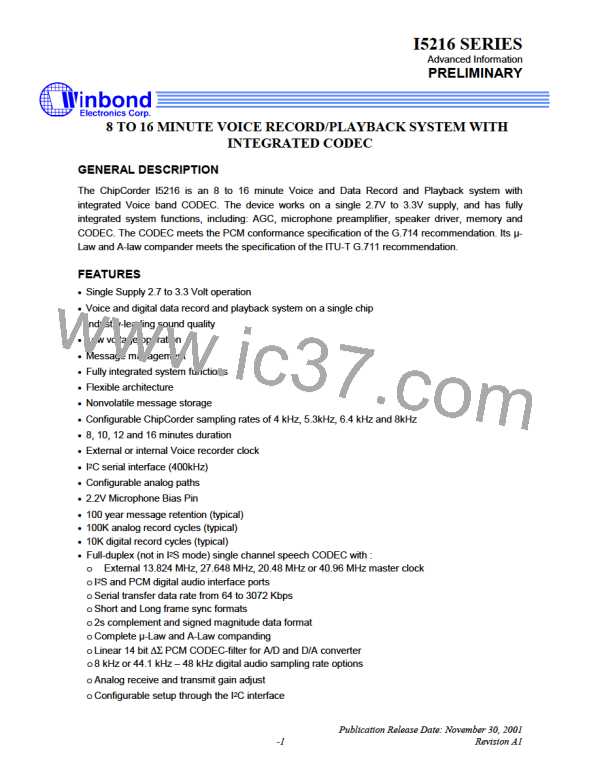I5216 SERIES
Advanced Information
PRELIMINARY
MEMORY ORGANIZATION
The I5216 memory array is arranged as 1888 rows (or pages) of 2048 bits, for a total memory of
3,866,624 bits. The primary addressing for the 2048 pages is handled by 11 bits of address data in the
analog mode. At the 8 kHz sample rate, each page contains 256 milliseconds of audio. Thus, at 8 kHz
there is actually room for 8 minutes and 3 seconds of audio.
A memory page is 2048 bits organized as thirty-two 64-bit "blocks" when used for digital storage. The
contents of a page are either analog or digital. This is determined by instruction (op code) at the time
the data is written. A record of what is analog and what is digital, and where, is stored by the system
microcontroller in the message address table (MAT). The MAT is a table kept in the microcontroller
memory that defines the status of each message “block.” It can be stored back into the I5216 if the
power fails or the system is turned off. Use of this table allows for efficient message management.
Segments of messages can be stored wherever there is available space in the memory array. [This
is explained in detail for the Winbond I5008 in Applications Note #No.9 and will similarly be in a later
Note for the I5216.]
When a page is used for analog storage, the same 32 blocks are present, but there are 8 EOM (End-
of-Message) markers. This means that for each 4 blocks there is an EOM marker at the end. Thus,
when recording, the analog recording will stop at any one of eight positions. At 8 kHz, this results in a
resolution of 32 msec when ENDING an analog recording. Beginning an analog recording is limited to
the 256 msec resolution provided by the 11-bit address. A recording does not immediately stop when
the Stop command is issued, but continues until the 32-millisecond block is filled. Then a bit is placed
into the EOM memory to develop the interrupt that signals a message is finished playing in the
Playback mode.
Digital data is sent and received, serially, over the I2C interface. The data is serial-to-parallel converted
and stored in one of two alternating (commutating) 64-bit shift registers. When an input register is full,
it becomes the register that is parallel written into the array. The prior write register becomes the new
serial input register. A mechanism is built in to ensure there is always a register available for storing
new data.
Storing data in the memory is accomplished by accepting data, one byte at a time, and issuing an
acknowledgement. If data is coming in faster than it can be written, then the chip will not issue an
acknowledgement to the host microcontroller until it is ready.
The read mode is the opposite of the write mode. Data is read into one of two 64-bit registers from the
array and serially sent to the I2C port. (See Digital Mode on page 41 for details).
OPERATION MODES DESCRIPTION
I2C PORT
Important note: The content contained herein of the rest of this datasheet assumes that the
reader is familiar with the I2C serial interface. Additional information on I2C may be found in
the I2C section of this document. If you are not familiar with this serial protocol, please read
the I2C section to familiarize yourself with it. A significant amount of additional information on
I2C can also be found on the Philips web page at http://www.philips.com/.
Publication Release Date: November 30, 2001
-17
Revision A1

 WINBOND [ WINBOND ]
WINBOND [ WINBOND ]